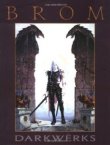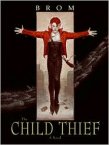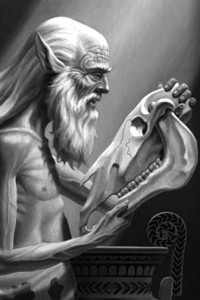Brom: Drawn to Darkness
 Gerald Brom was born March 9, 1965 in Albany GA to a military family. He spent his first few years in Japan, but was primarily raised in various places in the US, including three years in Hawaii, before graduating from high school in Frankfurt Germany.
Gerald Brom was born March 9, 1965 in Albany GA to a military family. He spent his first few years in Japan, but was primarily raised in various places in the US, including three years in Hawaii, before graduating from high school in Frankfurt Germany.
Brom attended art school in Atlanta GA, and worked as a commercial artist for several years before he started illustrating for comics. In 1989 took a job as a staff artist for the gaming company TSR, where he developed the look of the Dark Sun role playing game world . In 1993 he left TSR to become a full-time freelance artist. He has produced concept art and illustrations for collectible card games, films, and video games, as well as book covers. Some of his art has been collected in Darkwërks (1998) and Offerings (2001).
He turned to fiction writing with debut illustrated novel The Plucker (2005) and The Devil’s Rose (2007), followed by prose novel The Child Thief (2009), and the forthcoming Krampus: The Yule Lord (2012), both of which he also illustrated.
Brom lives near Seattle WA with his wife and two sons.
‘‘I was always drawing. My earliest memories are of going to the library and checking out dinosaur books to draw from (those were my dragons and monsters of the day). And in those first three years in Japan, I was hit with a barrage of wonderful superheroes and monsters. That was a great kick-starter for inspiration. If there was anything with skulls and bones on it, I was there. I can also blame my older brother for warping me from an early age. He’s three years older, and he collected Creepy and Eerie magazines and many other horror magazines. I would sneak into his room as a kid and devour these things.
‘‘As for actual learning to draw, I think it’s like most arts: it’s in you. You don’t even think, ‘Can I or can’t I do this?’ You just jump in and start doing it, and nobody can make you stop. And if you’re lucky, you progressively get better. I was self-taught, in that I would look at art that I liked and try to emulate it. Really, it was just doing a lot of bad paintings and learning from my mistakes.”
…
 ‘‘First Comics gave me my first job (they’re no longer in existence). The pay might have been all of $85 for a cover, but I was so happy doing these because it was what I loved! Then I heard about a gaming company called TSR in Wisconsin. I sent them my portfolio and they were marginally impressed. The lady who worked there mentioned that they had an on-staff opening. To me that would be a dream come true, so I invited myself up to show my portfolio and interview for the job. They said they had eight or nine other people that they were talking to, and of that list I was number ten, but they would keep my phone number.
‘‘First Comics gave me my first job (they’re no longer in existence). The pay might have been all of $85 for a cover, but I was so happy doing these because it was what I loved! Then I heard about a gaming company called TSR in Wisconsin. I sent them my portfolio and they were marginally impressed. The lady who worked there mentioned that they had an on-staff opening. To me that would be a dream come true, so I invited myself up to show my portfolio and interview for the job. They said they had eight or nine other people that they were talking to, and of that list I was number ten, but they would keep my phone number.
‘‘This was back in the ’80s before the Internet, and the only way to break into cover illustration was to live near the publishing houses. But I was determined, so my wife and I went up to New York and put a deposit down on an apartment. We had everything packed but the phone (I was waiting for a final call from my parents), and the phone rang. It was TSR. Apparently, the other nine people didn’t want to live in rural Wisconsin, so they offered me the job. I said, ‘I’ll take it!’ They asked, ‘How long would it take you to get out of your lease and move up here?’ I looked out the window at the U-Haul all packed and ready to go, and I said, ‘Oh, about eight hours.’
…
‘‘Every idea has been done, to some degree or another, and it’s more about combining ideas in unique ways. With The Plucker, I was intrigued to explore what happens when you combine the classical childhood fears with the magical world of make-believe and toys coming to life. I was curious as to what would happen if the two met face-to-face. So I wrote the story, did about ten illustrations, met with Robert Gould (also an artist, and somebody that often works with authors and helps them down the path of getting published), and we sold it to Abrams.
 ‘‘There were several challenges to selling an illustrated novel. When we first went around pitching it, most of the rejections weren’t based on the material but on the fact that the publishers did not know what to do with it. Their concern was, ‘Where do we put this in a bookstore?’ Too often, pictures and words are associated with children’s books. Though it contained toys and children’s themes, The Plucker was not a children’s book. But Abrams took a chance. Fortunately, the book has done well, and we’ve even gone back into a second expanded edition.”
‘‘There were several challenges to selling an illustrated novel. When we first went around pitching it, most of the rejections weren’t based on the material but on the fact that the publishers did not know what to do with it. Their concern was, ‘Where do we put this in a bookstore?’ Too often, pictures and words are associated with children’s books. Though it contained toys and children’s themes, The Plucker was not a children’s book. But Abrams took a chance. Fortunately, the book has done well, and we’ve even gone back into a second expanded edition.”
…
‘‘We’re at the transition point. With all the competition for the entertainment dollar, the book market has taken quite a hit. Budgets for covers have shrunk dramatically. Often they can’t afford the quality of artist they would like, and therefore turn to photocollage where they just take stock images and create a cover. But it’s very exciting seeing the Kindle Fire and the iPad come along. In the next two years, I think you’ll buy a book where you can zoom in on the cover, and it’s no longer a cost issue. You’re no longer limited so much by color printing budgets.
‘‘The market just needs a couple more years to mature, and the technology as well. Already Apple is coming out with free software to streamline self-publishing and make it easier. The downside of having it so easy to self-publish is you do get a glut of material that maybe should have never been published in the first place. I’m hoping the market will evolve. I see a real opportunity for the visual and the word to combine, and some of the old prejudice against words and pictures together as somehow being a ‘children’s book’ evaporating.”
Read the complete interview, and biographical profile, in the April 2012 issue of Locus Magazine.


 Excerpts from the interview:
Excerpts from the interview:



Pingback:SF Tidbits for 4/9/12 - SF Signal – A Speculative Fiction Blog